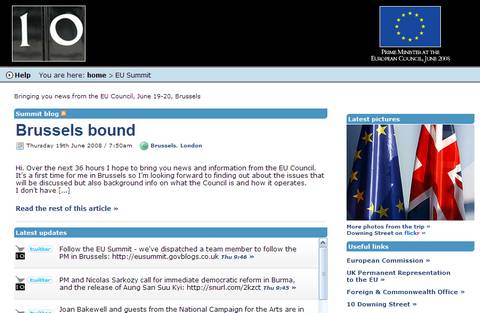It’s a busy couple of weeks for Puffbox, with several high-profile projects all delivering within a matter of days. First to appear is a quite radical reworking of the website for the Ministry of Justice‘s Governance of Britain project.
The site was originally built in late 2007 as a simple news hub, gathering updates on the various consultation processes and legislative processes across government. I think it’s fair to say, it was fairly modest. But things moved up a gear a few months ago, and the new site introduces some exciting new elements.
To attract attention and spark debate, the team have commissioned some ‘celebrity’ content from some extremely famous names. First contributions are from John Bird (Big Issue) and Adam Sampson (Shelter), two well-known NGO figures; and Dr Tim Edensor, an academic from Manchester Met University. Once the site beds in a bit, we’ll be posting some megastar-level contributions which are guaranteed to attract proper media attention.
Video will be a key element of the new site. Every week or two, we’ll be posting new video contributions, and inviting readers to comment blog-style. We’ll be starting with a few ‘official’ messages from Ministers and ‘famous faces’. But when I mentioned the plans in a comment on Shane McCracken’s blog earlier this week, Shane followed up by asking if we were going to accept video responses too. It was an excellent suggestion, and we’re already looking at how we could do it.
We’ve also added a Google Map showing past and future public events: some are official MOJ events; others are third-party events with Ministerial appearances; others have no MOJ connection, but are offered FYI. Nothing too clever from a technical perspective, but a nice addition nonetheless.
My own favourite part of the old site – the ‘What Others Are Saying‘ list of recommended articles from external blogs and websites, managed through a del.icio.us account – retains its homepage prominence. It’s a great way to demonstrate you’re listening to the wider debate, and a useful service to your readership: managed with a single mouse-click. It’s a feature I’d love to see on a lot more sites.
Obviously it’s all done through WordPress. It isn’t flashy; but I’m really excited about its potential. There’s no shortage of substance, on subjects we know people are interested in. It’s one of the first sites to use video as more than just a one-way medium. Ministers and the Comms team recognise the need to develop momentum, and I’m confident we’ll get regular involvement from senior levels. Let the debate begin.
 I can’t make my mind up about the
I can’t make my mind up about the 
 The challenge for the power of information taskforce is to get our civil servants to engage in online communities in an appropriate manner. Clearly, one of the things that underpins our hard-working public servants is the notion of common sense, and I hope that they will apply that in their online activities as much as their offline activities.
The challenge for the power of information taskforce is to get our civil servants to engage in online communities in an appropriate manner. Clearly, one of the things that underpins our hard-working public servants is the notion of common sense, and I hope that they will apply that in their online activities as much as their offline activities.